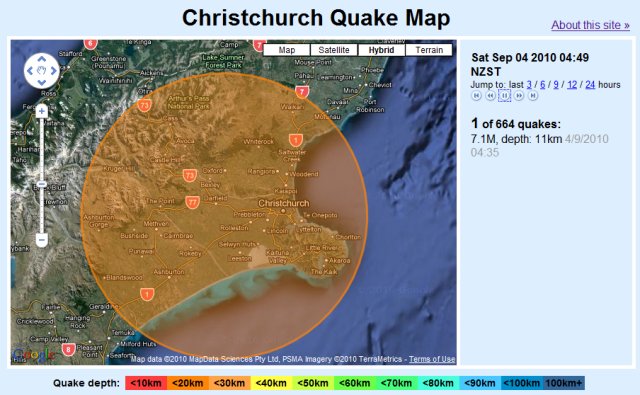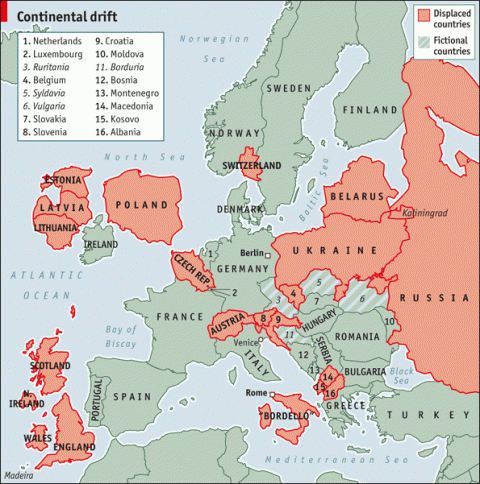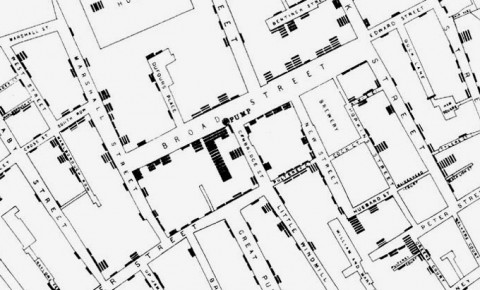When the first explorers from the warm lands around the Circle Sea travelled into the chilly hinterland they filled in the blank spaces on their maps by grabbing the nearest native, pointing at some distant landmark, speaking very clearly in a loud voice, and writing down whatever the bemused man told them. Thus were immortalised in generations of atlases such geographical oddities as Just A Mountain, I Don’t Know, What? and, of course, Your Finger You Fool.
Terry Pratchett, The Light Fantastic, 1986
September 27, 2010
QotD: Explorers and translation
Europe according to . . .
Amusing infographic source including “Europe according to France”:
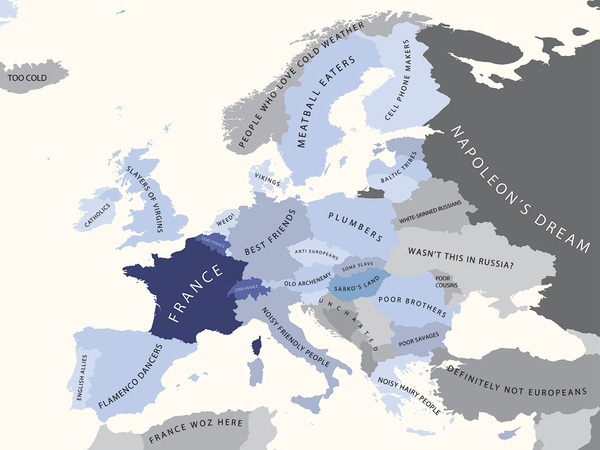
H/T to Cory Doctorow for the link.
September 16, 2010
Christchurch: that shaky town
To get an idea of what the poor folks in Christchurch are still going through, here is a visualization of the 664 tremors (to date):
Click here to see the full series.
H/T to Nelson Kennedy for the link.
July 17, 2010
Control of the Middle East, historically and graphically
A graphical presentation like this necessarily simplifies, but it’s still quite informative at the macro level (Maps of War):
H/T to Ghost of a Flea for the link.
June 23, 2010
Shake, rattle and roll
At about quarter to two this afternoon, my house shook for several seconds as an earthquake measuring 5.5 struck just north of Ottawa:

H/T to Colby Cosh for the graphic link.
Update: More information from the National Post:
A moderate earthquake was felt in parts of Southern Ontario and as far as Ottawa and Montreal. The U.S. Geological Survey has reported that an earthquake measuring 5.5 struck Southern Ontario, Quebec and a large part of the Eastern U.S. According to the USGS the quake was centered around 49 km from Cumberland, Ont.
According to reports a few tremors can still be felt after minutes after the initial quake but so far there are no reports of damage.
May 28, 2010
Is it too late to cancel?
Chris Selley rounds up the (almost unanimous) pundits’ opinions about the billion-dollar-boondoggle-summit-set:
Is it too late to cancel the G8 and G20 summits?
The National Post‘s Don Martin for the win: “No amount of righteous government bluster about living in post-9/11 protection paranoia, last week’s bank firebombing in Ottawa or the precedent of hosting two back-to-back summits can explain how an $18-million security tab for the G20 in Pittsburgh last September, which involved 4,000 police, must balloon to a billion dollars in Toronto requiring 10,000 cops on the ground.” Yup. It’s outrageous, and the government seems very oddly . . . proud of it. We can hardly wait for the Auditor-General and Parliamentary Budget Officer to find out just where this money went. Especially in a climate where Canadians are thoroughly cheesed off about government spending in the first place, it’s not too much of a stretch to say this is the sort of issue that might bring down a government.
“A case of bureaucracy gone wild,” is Jeffrey Simpson‘s uncontroversial verdict in The Globe and Mail, “or planning gone crazy, of fear sinking itself into every official’s and security person’s heart.” Imagine what we could have bought with that $1-billion! A bunch more Canada Research Chairs, or a whack of “clean-energy projects,” or assistance for “cultural groups” — so sleepy — or, hey, now we’re talking, a massive injection of cash for infrastructure on aboriginal reserves. Or, as Simpson says, “whatever.” Almost literally anything would be better. We’d arguably be better off flushing the $1-billion down the john.
For those of you looking forward to suffering through the event, here’s the official map of the restricted area around the Metro Convention Centre:
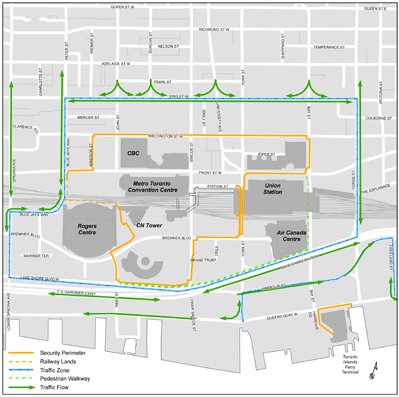
The best advice — unless you’re hoping for a run-in with the police — is to avoid Toronto for that weekend (plus a few days in either direction).
April 30, 2010
European map, rationalized
The Economist would like to redraw the map of Europe:
People who find their neighbours tiresome can move to another neighbourhood, whereas countries can’t. But suppose they could. Rejigging the map of Europe would make life more logical and friendlier.
Britain, which after its general election will have to confront its dire public finances, should move closer to the southern-European countries that find themselves in a similar position. It could be towed to a new position near the Azores. (If the journey proves a bumpy one, it might be a good opportunity to make Wales and Scotland into separate islands).
In Britain’s place should come Poland, which has suffered quite enough in its location between Russia and Germany and deserves a chance to enjoy the bracing winds of the North Atlantic and the security of sea water between it and any potential invaders.
April 27, 2010
Almost right
Kathy Shaidle linked to this map at Spleenville, showing an approximation of how Europeans (and implicitly the rest of the world) view the United States:
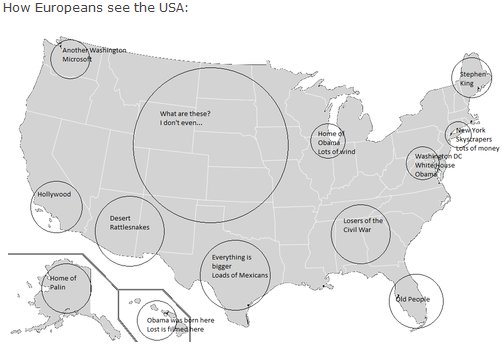
(Click map to see original image)
[. . .] As a matter of fact, from what I’ve garnered from across the pond, the rest of the world thinks the USA consists of one large metropolis — Newyorkangeles — with a sunny beach where only blond, tanned, perfectly-toned twenty-something models are allowed to go, and the rest of it is a desert wasteland full of racist white cowboys who wear big hats and shoot their guns in the air.
You forgot the teeth: Europeans all seem to believe that Americans all have identical “Hollywood” smiles. Oh, except for the gun-toting racist yahoos, who only have a few teeth each.
September 17, 2009
Another example of public funding misdirected
Following up from a post the other day, here’s another example of public money being used to create something, but the public (who funded the development through their taxes) not being allowed to use the result for free:
Wikileaks is hosting a copy of the “all 1,841,177 post codes together with precise geographic coordinates and other information” for the UK.
One odd thing about Britain is that databases produced at public expense — maps of the country, lists of postal codes, transcripts of Parliamentary debate and so on — do not belong to the public. In order to use this data, you have to pay gigantic licensing fees to the government, who accordingly threatens to sue people who use them without permission.
September 8, 2009
John Snow and the start of modern epidemiology
Another “on this date” entry for you: in 1854, John Snow persuaded the local authorities in a London borough to remove the handle from a water pump at the centre of a cholera outbreak. The move was successful, and the death rate dropped immediately. Randy Alfred has the story:
Physician John Snow convinces a London local council to remove the handle from a pump in Soho. A deadly cholera epidemic in the neighborhood comes to an end immediately, though perhaps serendipitously. Snow maps the outbreak to prove his point . . . and launches modern epidemiology.
The Soho neighborhood was not then filled with galleries, clubs, restaurants and other fine urban diversions. Some of it was an unsanitary slum where centuries-old cesspits sat chockablock with the wells that provided drinking water to a crowded populace.
Asiatic cholera had stricken Britain in successive waves since 1831. Snow, an obstetrician who pioneered the use of anesthesia in Britain, published On the Mode of Communication of Cholera in 1849. His hypothesis (and supporting data) held that the scourge was caused by sewage pollution in drinking water and “always commences with disturbances of the functions of the alimentary canal.”
July 21, 2009
iPhone as convenient marijuana lookup device
This is quite a cool idea:
We’ve seen a lot of unexpected, and sometimes cool, iPhone apps approved by Apple, but today’s news might top the rest. Apple has approved a marijuana — that’s right, marijuana — app called “Cannabis,” which lets users find the nearest (don’t worry: legal) supplier of medicinal marijuana.
Created by the founder of Ajnag.com, which was founded in 2006 and was the first medicinal marijuana locater on the Web, the new app is quick and easy to use. Simply open it up on your iPhone or iPod Touch and you’ll see a map with the nearest distributors. The app gives you information on each of the locations, and even step-by-step directions with Google Maps.
That’s not all, though — the creators thought of everything. If you run into any, erm, legal troubles with your newly-secured marijuana, Cannabis also gives you the locations of the nearest lawyers who specialize in marijuana cases. And, if you happen to live in one of the 37 states where marijuana is not legal, the app also provides you with the location of the nearest marijuana activist groups — so you can do your part to promote reform.

